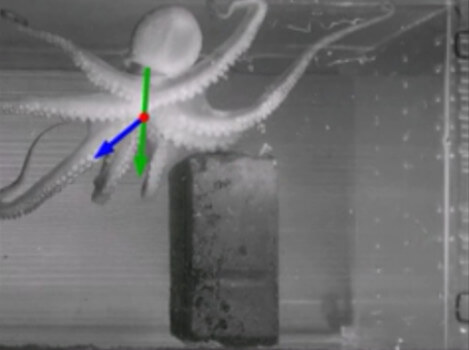The octopus can crawl in any direction relative to the orientation of its body. The orientation of the body and the directions of the crawl are controlled separately and the crawl lacks any rhythm pattern in the coordination of the limbs. This is what researchers Benjamin Hochner and Guy Levy from the Hebrew University discovered

The body structure of octopuses is unique, and it includes a sophisticated brain and a soft body with bilateral symmetry, surrounded by eight radially symmetrical and extremely flexible arms. Now researchers report the first detailed kinematic analysis of octopus arm coordination in crawling mode, showing that these creatures have their own movement control strategy suited to the special shape. The study was published in the journal Current Biology on April 16.
Octopuses use a different form of mobility than any other animal," says Benjamin Hochner from the Hebrew University of Jerusalem. "This is most likely due to the soft mollusk body that led to the evolution of a "strange" morphology, which enabled efficient movement without a rigid skeleton.
Previous studies on the behavior of octopuses carried out by Hebrew University teams focused on the movement of the arms towards a goal such as reaching a goal or grabbing food, Hochner explains. The new study is the first to tackle the bigger question: How do octopuses manage to coordinate their eight flexible arms during movement?
Octopuses most likely evolved from clam-like creatures that had a protective exoskeleton and hardly needed to move. "During evolution, octopuses lost their heavy protective shell and became easier to maneuver on the one hand, but also more vulnerable on the other" says Guy Levy, research partner.
"Their movement abilities evolved and became much faster than a typical mollusk, probably to compensate for the lack of a shell."
The evolution of a typical shelled leg into slender legs and arms allows octopuses to be remarkably flexible. Their excellent vision together with a developed and large brain and their ability to camouflage themselves through color change make them successful hunters. But how do they control the movements of this impressive body?
After analyzing videos showing octopuses in motion, frame by frame, the researchers made some surprising discoveries, according to the new study. Despite the bilaterally symmetrical body, the octopus can crawl in any direction relative to the orientation of its body. The orientation of the body and the directions of the crawl are controlled separately and the crawl lacks any rhythmic pattern in the coordination of the limbs."
Hochner, Levy and their colleagues showed that this uncommon maneuverability of octopuses is derived from the radial symmetry of their arms around the body and the simple mechanism by which the arms create the impulse to crawl - push through extension. These two together create a mechanism according to which the central controller chooses from moment to moment which arm to use to push the body in the immediate direction." the researchers write. The animals are only required to choose which arm to activate to determine the direction of movement.
The findings support what we knew about the perception of overall movement direction. The traditional way to understand this was that the movement-based strategies were created to fit the body, but the researchers say that in the total organization, the control and the body developed together in the context of the environment with which the body comes into contact."
"The concept, borrowed from the field of robotics, claims that the optimal behavior of an autonomous robot or animal is achieved as a result of optimizing the mutual and dynamic interactions between the brain, the body and the constantly changing environment, which leads to an optimal adaptation of the entire system to the ecological niche" says Levy. "An important virtue of this type of organization is that each level, including the physical features and morphology, contributes to the control of the observed behavior - and not just the brain as we tend to think."
Levy and Hochner say their next step will be to uncover the neural circuits involved in the octopus's coordinated crawl.
